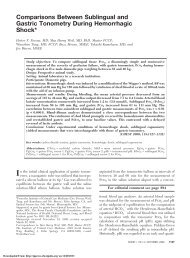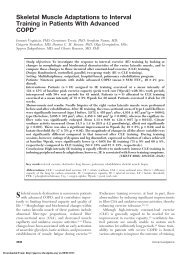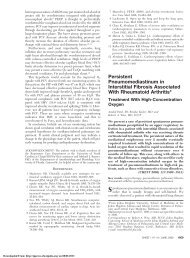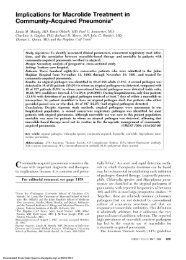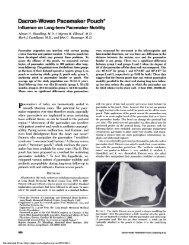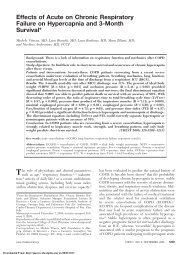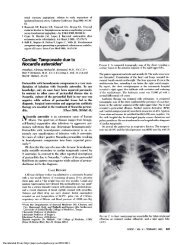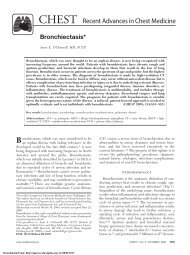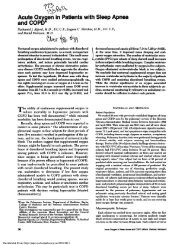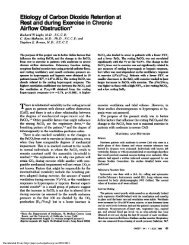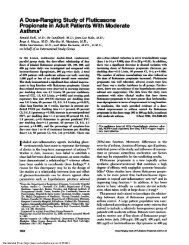Allergic bronchopulmonary aspergillosis - CHEST Publications ...
Allergic bronchopulmonary aspergillosis - CHEST Publications ...
Allergic bronchopulmonary aspergillosis - CHEST Publications ...
Create successful ePaper yourself
Turn your PDF publications into a flip-book with our unique Google optimized e-Paper software.
Table 1—Studies Describing the Prevalence of AH and/or ABPA in Patients with Bronchial Asthma Over the Last<br />
Two Decades*<br />
Study/Year Type of Study<br />
Type of Skin<br />
Test Type of Antigen<br />
Attapattu 31 /1991 Prospective Intradermal Commercial (Bencard<br />
Allergie; Munich,<br />
Germany)<br />
Eaton et al 33 /2000<br />
Kumar and Gaur<br />
Prospective Prick Commercial (Hollister-<br />
Stier Laboratories)<br />
34 /<br />
2000<br />
Base was performed for relevant studies published from<br />
1952 to 2008. A total of 250 articles were reviewed for the<br />
purpose of this article.<br />
Epidemiology of ABPA<br />
Aspergillus hypersensitivity (AH) is defined by the<br />
presence of an immediate-type cutaneous hypersensitivity<br />
to A fumigatus antigens, and it is the first step<br />
in the development of ABPA. 24 Only a minority of<br />
patients with AH develop the complete clinical<br />
picture of ABPA. 25 The population prevalence of<br />
ABPA in asthma, generally referred to as 1 to<br />
2%, 5,13,26,27 is based on the inference of only three<br />
studies (one peer-reviewed and two non–peer-reviewed<br />
studies). 28,29 In the only peer-reviewed<br />
study, 28 14 patients with allergic <strong>bronchopulmonary</strong><br />
mycosis were identified from a total of 1,390 new<br />
referrals in a catchment area population of half a<br />
million, estimating a period prevalence of just above<br />
1%. The other two non–peer-reviewed questionnaire-based<br />
studies suggested a maximum prevalence<br />
of ABPA of 1% in the United States. 29 In a<br />
recent metaanalysis, 30 we demonstrated a prevalence<br />
of AH and ABPA in asthma of 28% and 12.9%,<br />
respectively. The limitation noted in this review was<br />
that all the studies were performed in specialized<br />
clinics and may not be representative of the general<br />
population. Thus the exact population prevalence of<br />
ABPA remains speculative but is likely to be fairly<br />
Criteria Used for<br />
Diagnosis of ABPA<br />
Major (A/R/T/E/P)<br />
Minor (C)<br />
Prevalence of AH<br />
in Asthma (n/N)<br />
Prevalence of ABPA<br />
in Asthma (n/N)<br />
58/134 8/134<br />
Major (A/R/T/E/P/<br />
I/C/S)<br />
47/255 9/35<br />
Prospective Intradermal Locally prepared Major (A/R/T/E/P/<br />
I/C/S)<br />
Minor (C/S/B)<br />
47/200 32/200<br />
Al-Mobeireek et al 20 / Prospective Prick Commercial (Soluprick;<br />
12/53<br />
2001<br />
ALK Laboratories;<br />
Wallingford, CT)<br />
Maurya et al 35 /2005 Prospective Intradermal Locally prepared Major (A/R/T/E/P/<br />
I/C/S)<br />
Minor (C/S)<br />
30/105 8/105<br />
Agarwal et al 23 /2007 Prospective Intradermal Commercial (Hollister- Major (A/R/T/E/P/ 291/755 155/755<br />
Stier Laboratories) I/C/S)<br />
Minor (S/B)<br />
Prasad et al 36 /2008 Prospective Intradermal Not available Major (A/R/T/E/P/<br />
I/C/S)<br />
Minor (C/S/B)<br />
74/244 18/244<br />
* Criteria for ABPA: Major (A asthma, R radiologic opacities, T immediate positive skin test, E eosinophilia, P precipitins to A<br />
fumigatus, I IgE elevated, C central bronchiectasis, S specific IgG/IgE to A fumigatus); Minor (C sputum cultures of A fumigatus,<br />
S type III skin test positivity, B brownish black mucus plugs).<br />
high in patients attending asthma clinics. Table 1<br />
summarizes the prevalence of ABPA in patients with<br />
asthma reported in various studies 20,23,31–36 over the<br />
last two decades. The prevalence of ABPA in patients<br />
admitted with acute severe asthma is even<br />
higher. In a recent study of 57 patients with acute<br />
severe asthma admitted in the respiratory ICUs, we<br />
demonstrated the prevalence of AH and ABPA to be<br />
around 51% and 39%, respectively. 37 The occurrence<br />
of AH and ABPA was significantly higher in patients<br />
with acute asthma compared to the outpatient bronchial<br />
asthma (around 39% and 21%, respectively). 23<br />
Pathogenesis of ABPA<br />
The susceptibility of asthmatic patients to develop<br />
ABPA is not fully understood (Fig 1). Some authors<br />
have reported that exposure to large concentrations<br />
of spores of A fumigatus may cause ABPA. 16,38–41<br />
Environmental factors are not considered the main<br />
pathogenetic factors because not all asthmatics develop<br />
ABPA despite being exposed to the same<br />
environment. In a genetically predisposed individual42–54<br />
(Table 2), inhaled conidia of A fumigatus<br />
persist and germinate into hyphae with release of<br />
antigens that compromise the mucociliary clearance,<br />
stimulate and breach the airway epithelial barrier,<br />
and activate the innate immunity of the lung. 55–58<br />
This leads to inflammatory cell influx and a resultant<br />
early- and late-phase inflammatory reaction. 59,60 The<br />
806 Global Medicine<br />
Downloaded From: http://jupcvss.chestpubs.org/ on 08/01/2013



